Analysis of Taxation Provisions in Lend-lease Group for Equity and Tax-related Factors
VerifiedAdded on 2024/04/26
|12
|2504
|456
AI Summary
This report delves into the taxation provisions followed by Lend-lease Group, focusing on equity components like issued capital, treasury securities, reserves, and retained earnings. It also discusses tax expenses, deferred tax assets and liabilities, and reconciling differences between accounting and tax laws.
Contribute Materials
Your contribution can guide someone’s learning journey. Share your
documents today.

HI5020 Corporate accounting
1
1
Secure Best Marks with AI Grader
Need help grading? Try our AI Grader for instant feedback on your assignments.
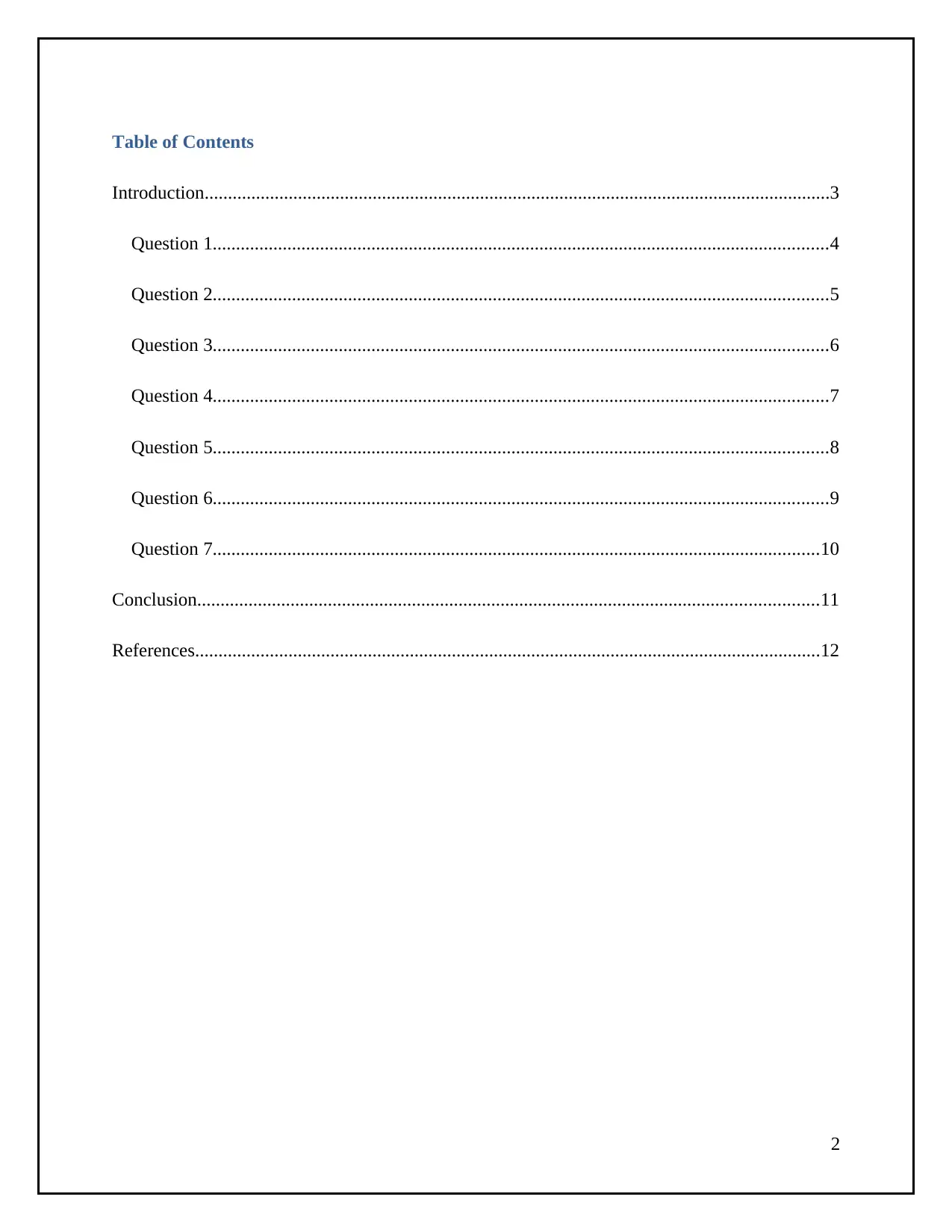
Table of Contents
Introduction......................................................................................................................................3
Question 1....................................................................................................................................4
Question 2....................................................................................................................................5
Question 3....................................................................................................................................6
Question 4....................................................................................................................................7
Question 5....................................................................................................................................8
Question 6....................................................................................................................................9
Question 7..................................................................................................................................10
Conclusion.....................................................................................................................................11
References......................................................................................................................................12
2
Introduction......................................................................................................................................3
Question 1....................................................................................................................................4
Question 2....................................................................................................................................5
Question 3....................................................................................................................................6
Question 4....................................................................................................................................7
Question 5....................................................................................................................................8
Question 6....................................................................................................................................9
Question 7..................................................................................................................................10
Conclusion.....................................................................................................................................11
References......................................................................................................................................12
2
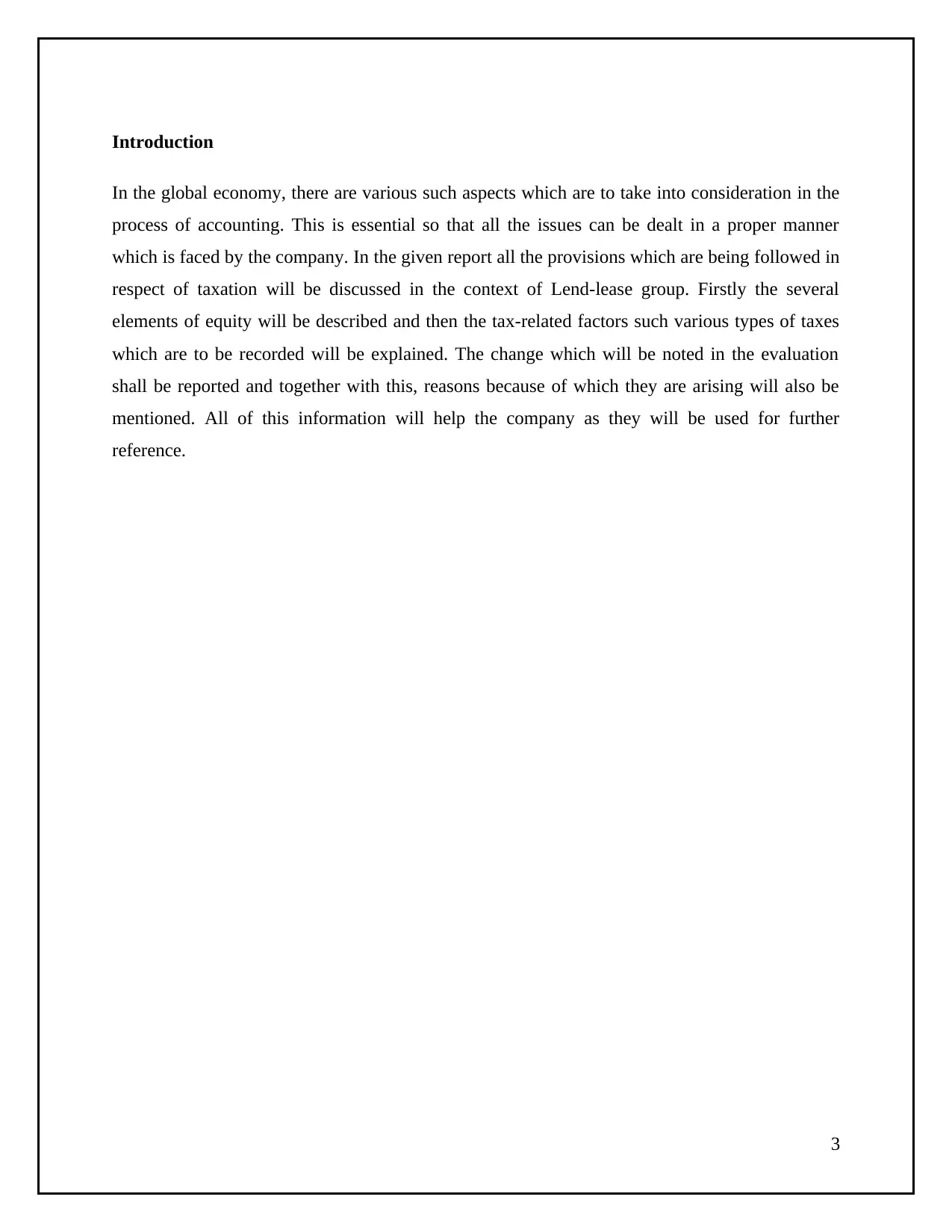
Introduction
In the global economy, there are various such aspects which are to take into consideration in the
process of accounting. This is essential so that all the issues can be dealt in a proper manner
which is faced by the company. In the given report all the provisions which are being followed in
respect of taxation will be discussed in the context of Lend-lease group. Firstly the several
elements of equity will be described and then the tax-related factors such various types of taxes
which are to be recorded will be explained. The change which will be noted in the evaluation
shall be reported and together with this, reasons because of which they are arising will also be
mentioned. All of this information will help the company as they will be used for further
reference.
3
In the global economy, there are various such aspects which are to take into consideration in the
process of accounting. This is essential so that all the issues can be dealt in a proper manner
which is faced by the company. In the given report all the provisions which are being followed in
respect of taxation will be discussed in the context of Lend-lease group. Firstly the several
elements of equity will be described and then the tax-related factors such various types of taxes
which are to be recorded will be explained. The change which will be noted in the evaluation
shall be reported and together with this, reasons because of which they are arising will also be
mentioned. All of this information will help the company as they will be used for further
reference.
3
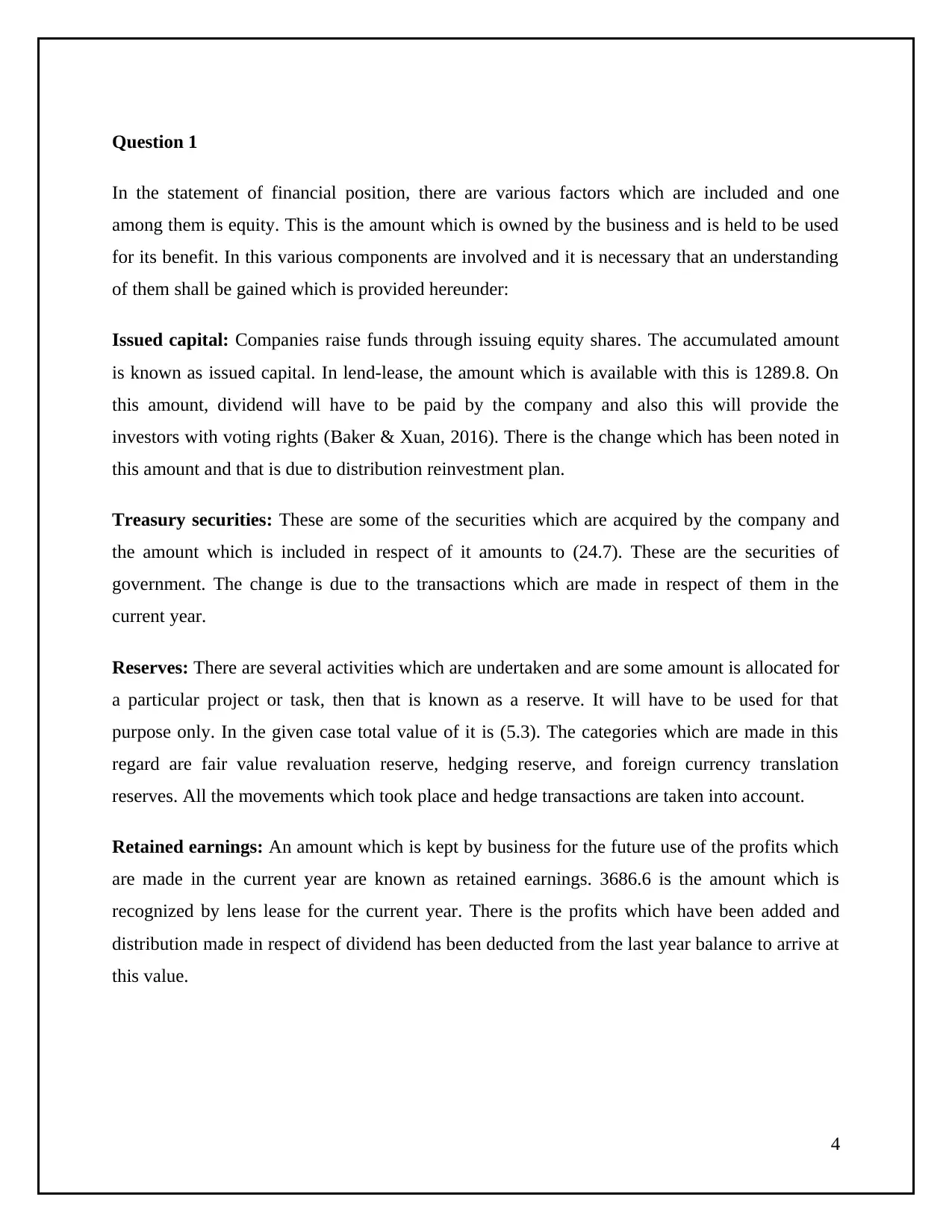
Question 1
In the statement of financial position, there are various factors which are included and one
among them is equity. This is the amount which is owned by the business and is held to be used
for its benefit. In this various components are involved and it is necessary that an understanding
of them shall be gained which is provided hereunder:
Issued capital: Companies raise funds through issuing equity shares. The accumulated amount
is known as issued capital. In lend-lease, the amount which is available with this is 1289.8. On
this amount, dividend will have to be paid by the company and also this will provide the
investors with voting rights (Baker & Xuan, 2016). There is the change which has been noted in
this amount and that is due to distribution reinvestment plan.
Treasury securities: These are some of the securities which are acquired by the company and
the amount which is included in respect of it amounts to (24.7). These are the securities of
government. The change is due to the transactions which are made in respect of them in the
current year.
Reserves: There are several activities which are undertaken and are some amount is allocated for
a particular project or task, then that is known as a reserve. It will have to be used for that
purpose only. In the given case total value of it is (5.3). The categories which are made in this
regard are fair value revaluation reserve, hedging reserve, and foreign currency translation
reserves. All the movements which took place and hedge transactions are taken into account.
Retained earnings: An amount which is kept by business for the future use of the profits which
are made in the current year are known as retained earnings. 3686.6 is the amount which is
recognized by lens lease for the current year. There is the profits which have been added and
distribution made in respect of dividend has been deducted from the last year balance to arrive at
this value.
4
In the statement of financial position, there are various factors which are included and one
among them is equity. This is the amount which is owned by the business and is held to be used
for its benefit. In this various components are involved and it is necessary that an understanding
of them shall be gained which is provided hereunder:
Issued capital: Companies raise funds through issuing equity shares. The accumulated amount
is known as issued capital. In lend-lease, the amount which is available with this is 1289.8. On
this amount, dividend will have to be paid by the company and also this will provide the
investors with voting rights (Baker & Xuan, 2016). There is the change which has been noted in
this amount and that is due to distribution reinvestment plan.
Treasury securities: These are some of the securities which are acquired by the company and
the amount which is included in respect of it amounts to (24.7). These are the securities of
government. The change is due to the transactions which are made in respect of them in the
current year.
Reserves: There are several activities which are undertaken and are some amount is allocated for
a particular project or task, then that is known as a reserve. It will have to be used for that
purpose only. In the given case total value of it is (5.3). The categories which are made in this
regard are fair value revaluation reserve, hedging reserve, and foreign currency translation
reserves. All the movements which took place and hedge transactions are taken into account.
Retained earnings: An amount which is kept by business for the future use of the profits which
are made in the current year are known as retained earnings. 3686.6 is the amount which is
recognized by lens lease for the current year. There is the profits which have been added and
distribution made in respect of dividend has been deducted from the last year balance to arrive at
this value.
4
Paraphrase This Document
Need a fresh take? Get an instant paraphrase of this document with our AI Paraphraser
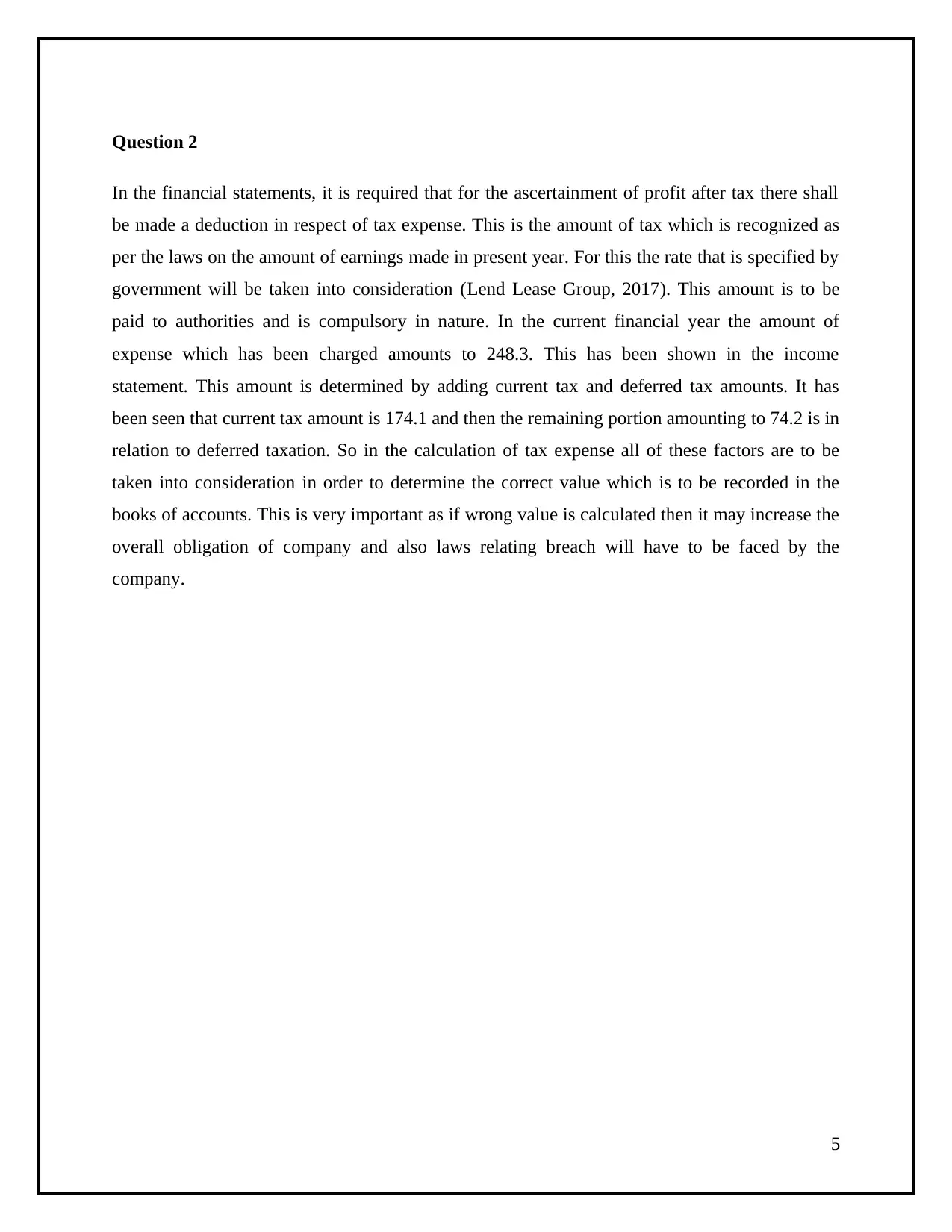
Question 2
In the financial statements, it is required that for the ascertainment of profit after tax there shall
be made a deduction in respect of tax expense. This is the amount of tax which is recognized as
per the laws on the amount of earnings made in present year. For this the rate that is specified by
government will be taken into consideration (Lend Lease Group, 2017). This amount is to be
paid to authorities and is compulsory in nature. In the current financial year the amount of
expense which has been charged amounts to 248.3. This has been shown in the income
statement. This amount is determined by adding current tax and deferred tax amounts. It has
been seen that current tax amount is 174.1 and then the remaining portion amounting to 74.2 is in
relation to deferred taxation. So in the calculation of tax expense all of these factors are to be
taken into consideration in order to determine the correct value which is to be recorded in the
books of accounts. This is very important as if wrong value is calculated then it may increase the
overall obligation of company and also laws relating breach will have to be faced by the
company.
5
In the financial statements, it is required that for the ascertainment of profit after tax there shall
be made a deduction in respect of tax expense. This is the amount of tax which is recognized as
per the laws on the amount of earnings made in present year. For this the rate that is specified by
government will be taken into consideration (Lend Lease Group, 2017). This amount is to be
paid to authorities and is compulsory in nature. In the current financial year the amount of
expense which has been charged amounts to 248.3. This has been shown in the income
statement. This amount is determined by adding current tax and deferred tax amounts. It has
been seen that current tax amount is 174.1 and then the remaining portion amounting to 74.2 is in
relation to deferred taxation. So in the calculation of tax expense all of these factors are to be
taken into consideration in order to determine the correct value which is to be recorded in the
books of accounts. This is very important as if wrong value is calculated then it may increase the
overall obligation of company and also laws relating breach will have to be faced by the
company.
5
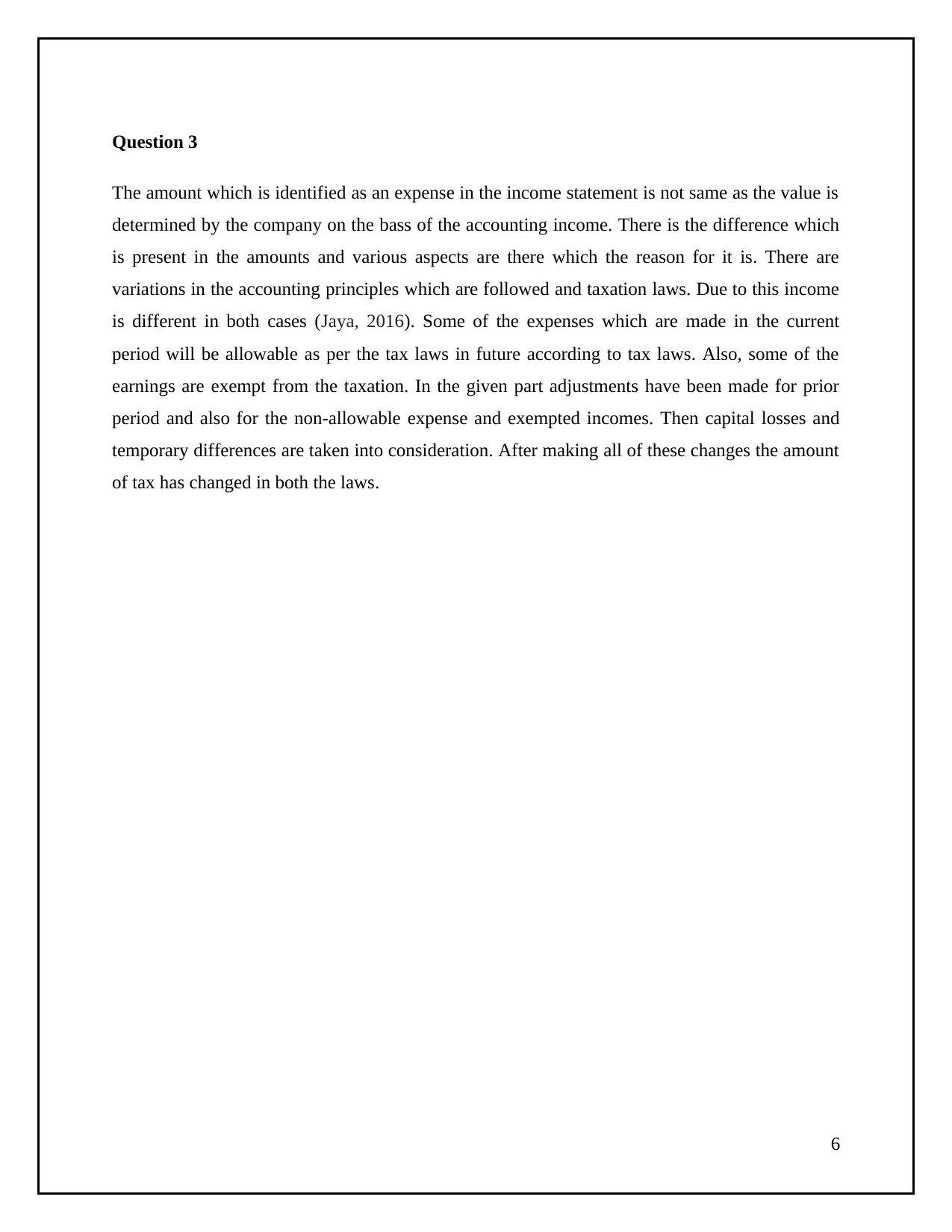
Question 3
The amount which is identified as an expense in the income statement is not same as the value is
determined by the company on the bass of the accounting income. There is the difference which
is present in the amounts and various aspects are there which the reason for it is. There are
variations in the accounting principles which are followed and taxation laws. Due to this income
is different in both cases (Jaya, 2016). Some of the expenses which are made in the current
period will be allowable as per the tax laws in future according to tax laws. Also, some of the
earnings are exempt from the taxation. In the given part adjustments have been made for prior
period and also for the non-allowable expense and exempted incomes. Then capital losses and
temporary differences are taken into consideration. After making all of these changes the amount
of tax has changed in both the laws.
6
The amount which is identified as an expense in the income statement is not same as the value is
determined by the company on the bass of the accounting income. There is the difference which
is present in the amounts and various aspects are there which the reason for it is. There are
variations in the accounting principles which are followed and taxation laws. Due to this income
is different in both cases (Jaya, 2016). Some of the expenses which are made in the current
period will be allowable as per the tax laws in future according to tax laws. Also, some of the
earnings are exempt from the taxation. In the given part adjustments have been made for prior
period and also for the non-allowable expense and exempted incomes. Then capital losses and
temporary differences are taken into consideration. After making all of these changes the amount
of tax has changed in both the laws.
6
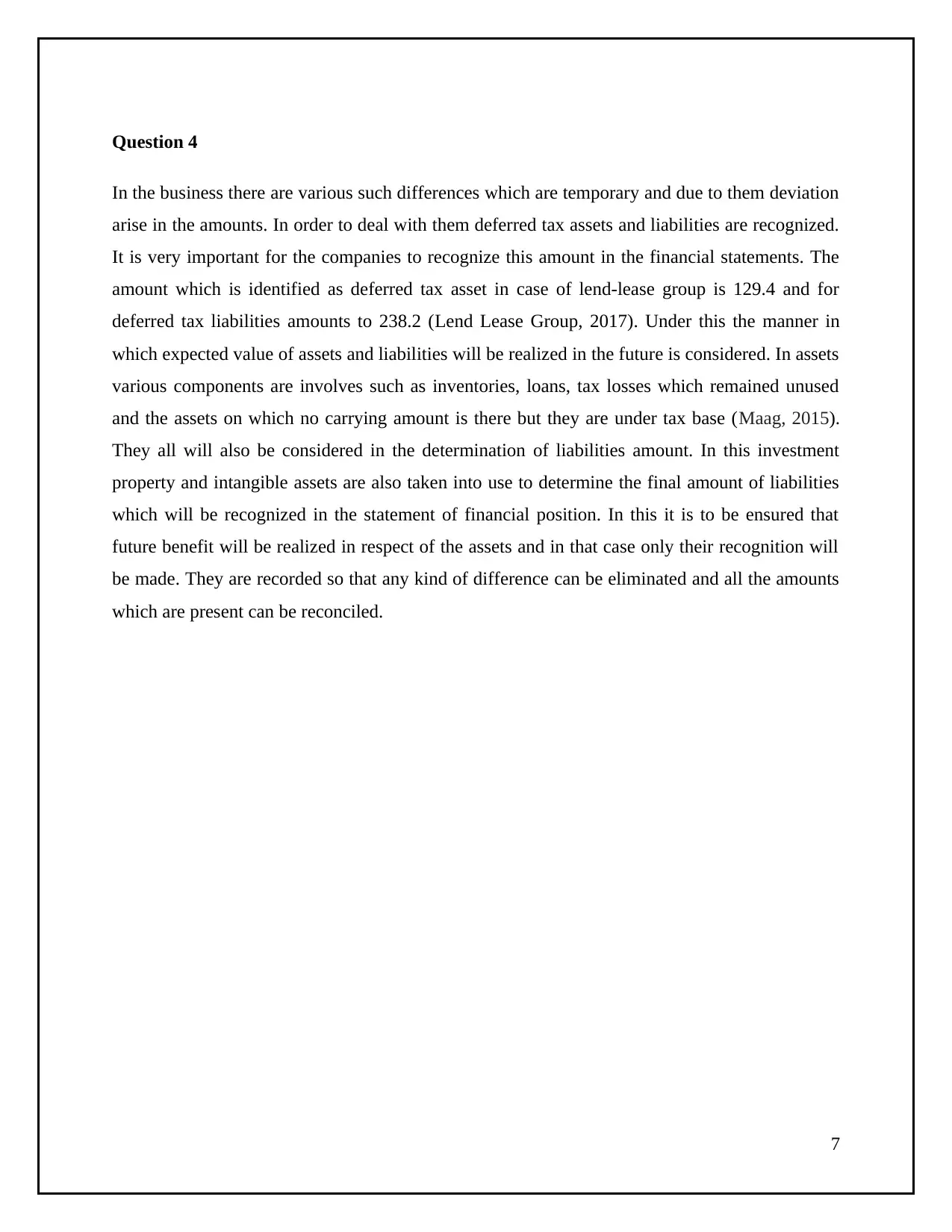
Question 4
In the business there are various such differences which are temporary and due to them deviation
arise in the amounts. In order to deal with them deferred tax assets and liabilities are recognized.
It is very important for the companies to recognize this amount in the financial statements. The
amount which is identified as deferred tax asset in case of lend-lease group is 129.4 and for
deferred tax liabilities amounts to 238.2 (Lend Lease Group, 2017). Under this the manner in
which expected value of assets and liabilities will be realized in the future is considered. In assets
various components are involves such as inventories, loans, tax losses which remained unused
and the assets on which no carrying amount is there but they are under tax base (Maag, 2015).
They all will also be considered in the determination of liabilities amount. In this investment
property and intangible assets are also taken into use to determine the final amount of liabilities
which will be recognized in the statement of financial position. In this it is to be ensured that
future benefit will be realized in respect of the assets and in that case only their recognition will
be made. They are recorded so that any kind of difference can be eliminated and all the amounts
which are present can be reconciled.
7
In the business there are various such differences which are temporary and due to them deviation
arise in the amounts. In order to deal with them deferred tax assets and liabilities are recognized.
It is very important for the companies to recognize this amount in the financial statements. The
amount which is identified as deferred tax asset in case of lend-lease group is 129.4 and for
deferred tax liabilities amounts to 238.2 (Lend Lease Group, 2017). Under this the manner in
which expected value of assets and liabilities will be realized in the future is considered. In assets
various components are involves such as inventories, loans, tax losses which remained unused
and the assets on which no carrying amount is there but they are under tax base (Maag, 2015).
They all will also be considered in the determination of liabilities amount. In this investment
property and intangible assets are also taken into use to determine the final amount of liabilities
which will be recognized in the statement of financial position. In this it is to be ensured that
future benefit will be realized in respect of the assets and in that case only their recognition will
be made. They are recorded so that any kind of difference can be eliminated and all the amounts
which are present can be reconciled.
7
Secure Best Marks with AI Grader
Need help grading? Try our AI Grader for instant feedback on your assignments.

Question 5
The company has entered the current tax liabilities in its books which are amounting to 6.4. This
amount which is shown in balance sheet is not similar to that of the value that is taken as tax
expense. All the laws which are applicable on company in respect of accounting and taxation are
difference from each other. The amount of tax which will be calculated by them will also be
different (Lend Lease Group, 2017). The earnings in both cases are different as some of the
transactions which are involved in accounting will not be included for tax purpose in that year
only. So for that they are required to be adjusted. All the expense which is allowed in the current
year will be taken for the calculation of tax expense. But the amount which will be left and the
benefit of which will not be received now will not be taken into account in current year (Shamki,
2014). They are to be allowed in next year and so will be taken as tax payable in current
liabilities head. As they are current so, will be met by company in the coming period of one year.
So it can be said that in order to reconcile the tax and accounting laws, amount which is the
difference in them is taken as the payable and by that way all the deviations which are present
among them are eliminated.
8
The company has entered the current tax liabilities in its books which are amounting to 6.4. This
amount which is shown in balance sheet is not similar to that of the value that is taken as tax
expense. All the laws which are applicable on company in respect of accounting and taxation are
difference from each other. The amount of tax which will be calculated by them will also be
different (Lend Lease Group, 2017). The earnings in both cases are different as some of the
transactions which are involved in accounting will not be included for tax purpose in that year
only. So for that they are required to be adjusted. All the expense which is allowed in the current
year will be taken for the calculation of tax expense. But the amount which will be left and the
benefit of which will not be received now will not be taken into account in current year (Shamki,
2014). They are to be allowed in next year and so will be taken as tax payable in current
liabilities head. As they are current so, will be met by company in the coming period of one year.
So it can be said that in order to reconcile the tax and accounting laws, amount which is the
difference in them is taken as the payable and by that way all the deviations which are present
among them are eliminated.
8
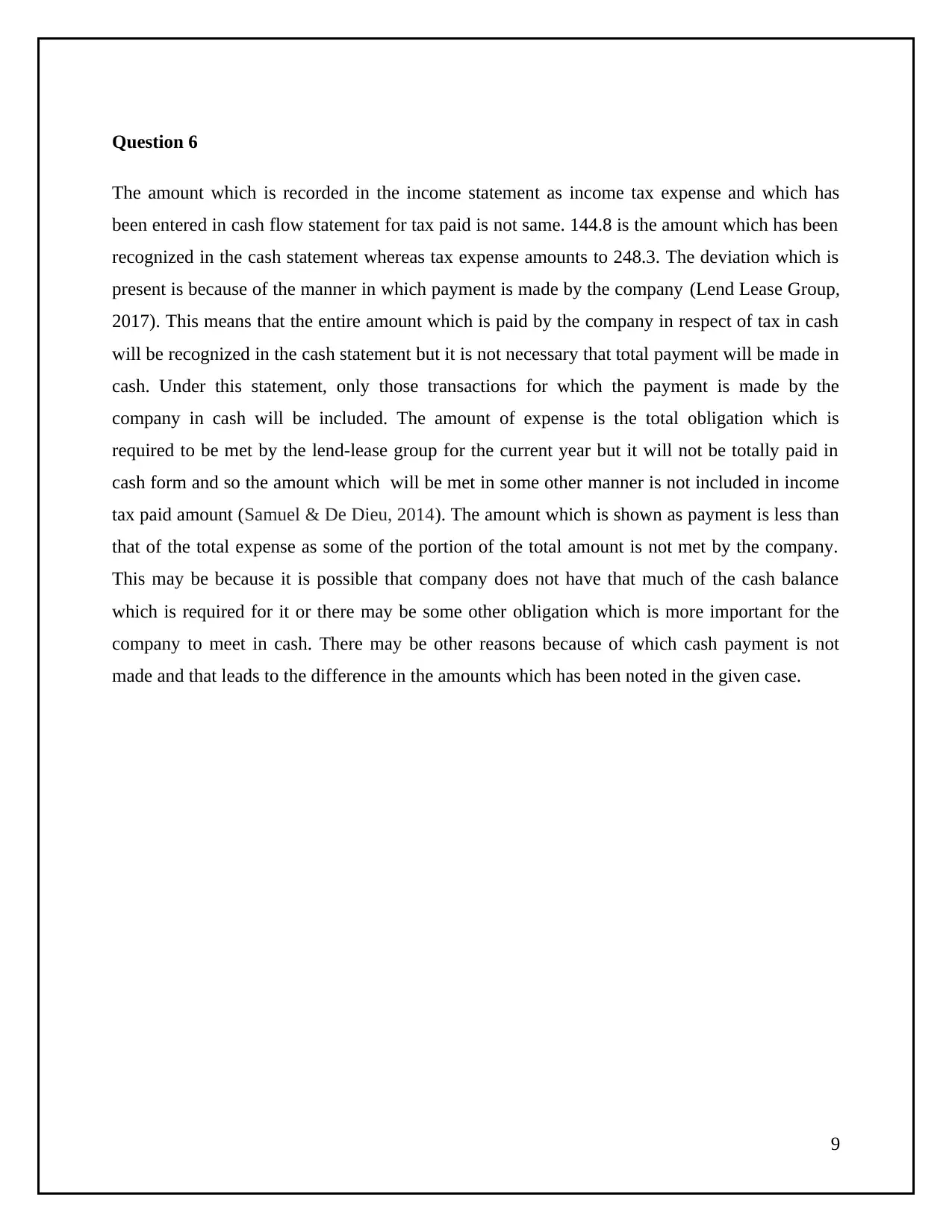
Question 6
The amount which is recorded in the income statement as income tax expense and which has
been entered in cash flow statement for tax paid is not same. 144.8 is the amount which has been
recognized in the cash statement whereas tax expense amounts to 248.3. The deviation which is
present is because of the manner in which payment is made by the company (Lend Lease Group,
2017). This means that the entire amount which is paid by the company in respect of tax in cash
will be recognized in the cash statement but it is not necessary that total payment will be made in
cash. Under this statement, only those transactions for which the payment is made by the
company in cash will be included. The amount of expense is the total obligation which is
required to be met by the lend-lease group for the current year but it will not be totally paid in
cash form and so the amount which will be met in some other manner is not included in income
tax paid amount (Samuel & De Dieu, 2014). The amount which is shown as payment is less than
that of the total expense as some of the portion of the total amount is not met by the company.
This may be because it is possible that company does not have that much of the cash balance
which is required for it or there may be some other obligation which is more important for the
company to meet in cash. There may be other reasons because of which cash payment is not
made and that leads to the difference in the amounts which has been noted in the given case.
9
The amount which is recorded in the income statement as income tax expense and which has
been entered in cash flow statement for tax paid is not same. 144.8 is the amount which has been
recognized in the cash statement whereas tax expense amounts to 248.3. The deviation which is
present is because of the manner in which payment is made by the company (Lend Lease Group,
2017). This means that the entire amount which is paid by the company in respect of tax in cash
will be recognized in the cash statement but it is not necessary that total payment will be made in
cash. Under this statement, only those transactions for which the payment is made by the
company in cash will be included. The amount of expense is the total obligation which is
required to be met by the lend-lease group for the current year but it will not be totally paid in
cash form and so the amount which will be met in some other manner is not included in income
tax paid amount (Samuel & De Dieu, 2014). The amount which is shown as payment is less than
that of the total expense as some of the portion of the total amount is not met by the company.
This may be because it is possible that company does not have that much of the cash balance
which is required for it or there may be some other obligation which is more important for the
company to meet in cash. There may be other reasons because of which cash payment is not
made and that leads to the difference in the amounts which has been noted in the given case.
9
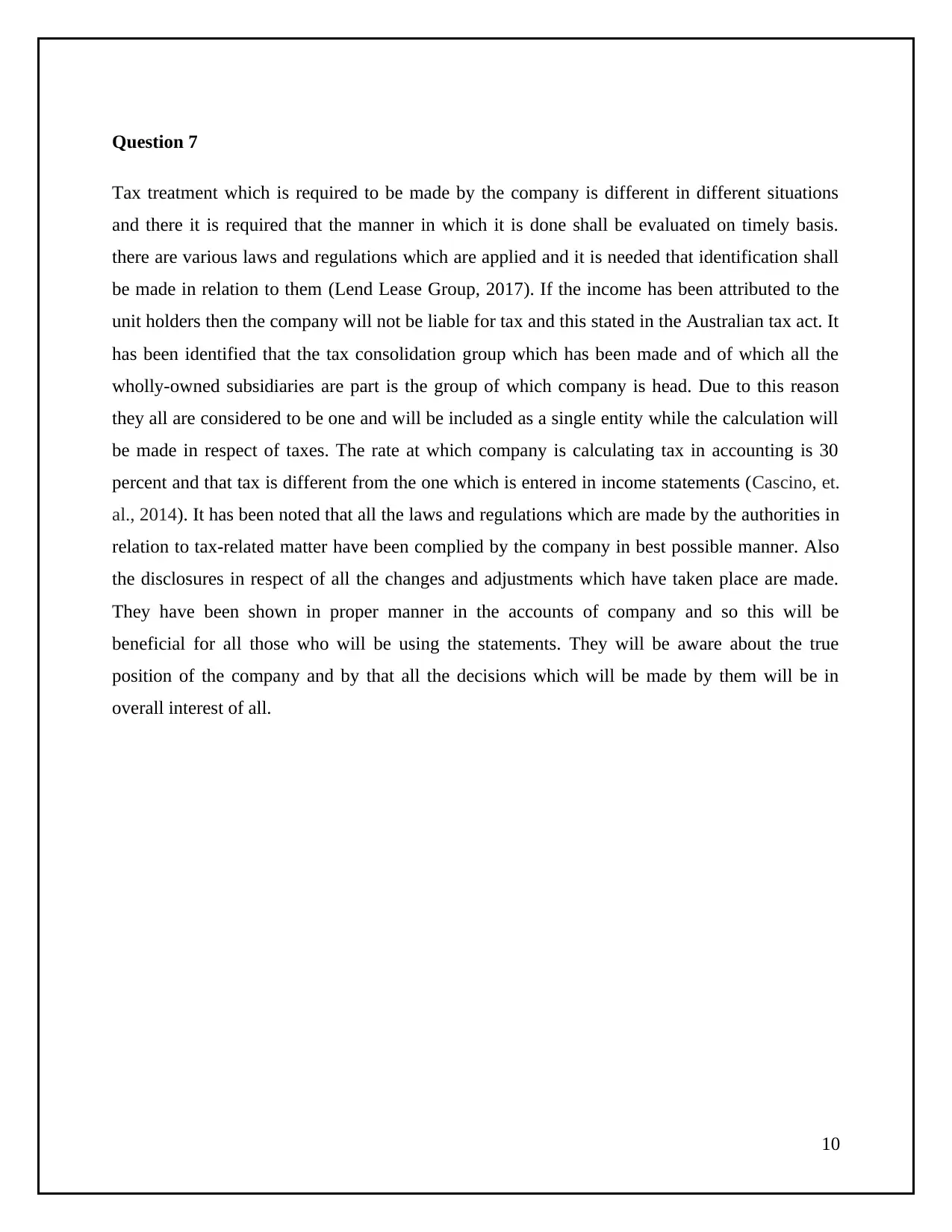
Question 7
Tax treatment which is required to be made by the company is different in different situations
and there it is required that the manner in which it is done shall be evaluated on timely basis.
there are various laws and regulations which are applied and it is needed that identification shall
be made in relation to them (Lend Lease Group, 2017). If the income has been attributed to the
unit holders then the company will not be liable for tax and this stated in the Australian tax act. It
has been identified that the tax consolidation group which has been made and of which all the
wholly-owned subsidiaries are part is the group of which company is head. Due to this reason
they all are considered to be one and will be included as a single entity while the calculation will
be made in respect of taxes. The rate at which company is calculating tax in accounting is 30
percent and that tax is different from the one which is entered in income statements (Cascino, et.
al., 2014). It has been noted that all the laws and regulations which are made by the authorities in
relation to tax-related matter have been complied by the company in best possible manner. Also
the disclosures in respect of all the changes and adjustments which have taken place are made.
They have been shown in proper manner in the accounts of company and so this will be
beneficial for all those who will be using the statements. They will be aware about the true
position of the company and by that all the decisions which will be made by them will be in
overall interest of all.
10
Tax treatment which is required to be made by the company is different in different situations
and there it is required that the manner in which it is done shall be evaluated on timely basis.
there are various laws and regulations which are applied and it is needed that identification shall
be made in relation to them (Lend Lease Group, 2017). If the income has been attributed to the
unit holders then the company will not be liable for tax and this stated in the Australian tax act. It
has been identified that the tax consolidation group which has been made and of which all the
wholly-owned subsidiaries are part is the group of which company is head. Due to this reason
they all are considered to be one and will be included as a single entity while the calculation will
be made in respect of taxes. The rate at which company is calculating tax in accounting is 30
percent and that tax is different from the one which is entered in income statements (Cascino, et.
al., 2014). It has been noted that all the laws and regulations which are made by the authorities in
relation to tax-related matter have been complied by the company in best possible manner. Also
the disclosures in respect of all the changes and adjustments which have taken place are made.
They have been shown in proper manner in the accounts of company and so this will be
beneficial for all those who will be using the statements. They will be aware about the true
position of the company and by that all the decisions which will be made by them will be in
overall interest of all.
10
Paraphrase This Document
Need a fresh take? Get an instant paraphrase of this document with our AI Paraphraser
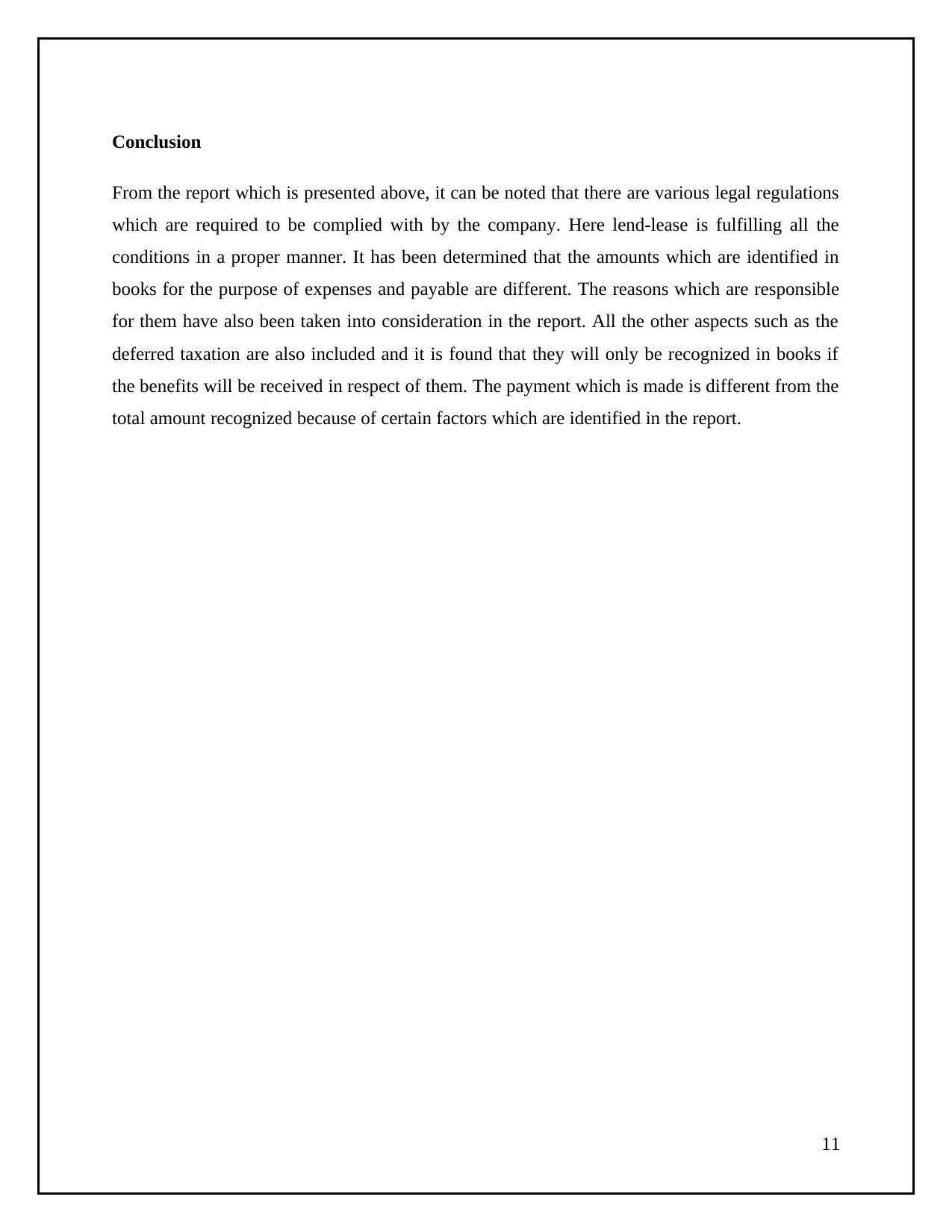
Conclusion
From the report which is presented above, it can be noted that there are various legal regulations
which are required to be complied with by the company. Here lend-lease is fulfilling all the
conditions in a proper manner. It has been determined that the amounts which are identified in
books for the purpose of expenses and payable are different. The reasons which are responsible
for them have also been taken into consideration in the report. All the other aspects such as the
deferred taxation are also included and it is found that they will only be recognized in books if
the benefits will be received in respect of them. The payment which is made is different from the
total amount recognized because of certain factors which are identified in the report.
11
From the report which is presented above, it can be noted that there are various legal regulations
which are required to be complied with by the company. Here lend-lease is fulfilling all the
conditions in a proper manner. It has been determined that the amounts which are identified in
books for the purpose of expenses and payable are different. The reasons which are responsible
for them have also been taken into consideration in the report. All the other aspects such as the
deferred taxation are also included and it is found that they will only be recognized in books if
the benefits will be received in respect of them. The payment which is made is different from the
total amount recognized because of certain factors which are identified in the report.
11

References
Akgün, A. İ. (2016). Quality Of The Financial Reporting Within The Ifrs: Research On
Determining The Attitudes And Evaluations Of Financial Information Users. Muhasebe Ve
Finansman Dergisi, (69).
Baker, M., & Xuan, Y. (2016). Under New Management: Equity Issues And The Attribution Of
Past Returns. Journal Of Financial Economics, 121(1), 66-78.
Cascino, S., Clatworthy, M., García Osma, B., Gassen, J., Imam, S., & Jeanjean, T. (2014). Who
Uses Financial Reports And For What Purpose? Evidence From Capital
Providers. Accounting In Europe, 11(2), 185-209.
Jaya, T. E. (2016). Earnings, Leverage, And Deferred Tax On Tax Penalties And Fines (Case
Study In Indonesia).
Lend Lease Group, (2017). Annual Report 2017. [Online] Lend Lease Group, 126-155.
Available At: Https://Www.Lendlease.Com/-/Media/Llcom/Investor-Relations/Annual-
Reports-And-Securityholder-Reviews/2017/2017-Annual-Report-For-Lendlease-Group.Ashx
[Accessed: 23 January 2017]
Maag, E. (2015). Earned Income Tax Credit In The United States. Journal Of Social Security
Law, 22(1), 20-30.
Samuel, M., & De Dieu, R. J. (2014). The Impact Of Taxpayers' Financial Statements Audit On
Tax Revenue Growth. International Journal Of Business And Economic Development
(Ijbed), 2(2).
Shamki, D. (2014). Owners’ Equity And Accounting Information Relevance. Procedia-Social
And Behavioral Sciences, 164, 194-200.
12
Akgün, A. İ. (2016). Quality Of The Financial Reporting Within The Ifrs: Research On
Determining The Attitudes And Evaluations Of Financial Information Users. Muhasebe Ve
Finansman Dergisi, (69).
Baker, M., & Xuan, Y. (2016). Under New Management: Equity Issues And The Attribution Of
Past Returns. Journal Of Financial Economics, 121(1), 66-78.
Cascino, S., Clatworthy, M., García Osma, B., Gassen, J., Imam, S., & Jeanjean, T. (2014). Who
Uses Financial Reports And For What Purpose? Evidence From Capital
Providers. Accounting In Europe, 11(2), 185-209.
Jaya, T. E. (2016). Earnings, Leverage, And Deferred Tax On Tax Penalties And Fines (Case
Study In Indonesia).
Lend Lease Group, (2017). Annual Report 2017. [Online] Lend Lease Group, 126-155.
Available At: Https://Www.Lendlease.Com/-/Media/Llcom/Investor-Relations/Annual-
Reports-And-Securityholder-Reviews/2017/2017-Annual-Report-For-Lendlease-Group.Ashx
[Accessed: 23 January 2017]
Maag, E. (2015). Earned Income Tax Credit In The United States. Journal Of Social Security
Law, 22(1), 20-30.
Samuel, M., & De Dieu, R. J. (2014). The Impact Of Taxpayers' Financial Statements Audit On
Tax Revenue Growth. International Journal Of Business And Economic Development
(Ijbed), 2(2).
Shamki, D. (2014). Owners’ Equity And Accounting Information Relevance. Procedia-Social
And Behavioral Sciences, 164, 194-200.
12
1 out of 12
![[object Object]](/_next/static/media/star-bottom.7253800d.svg)





